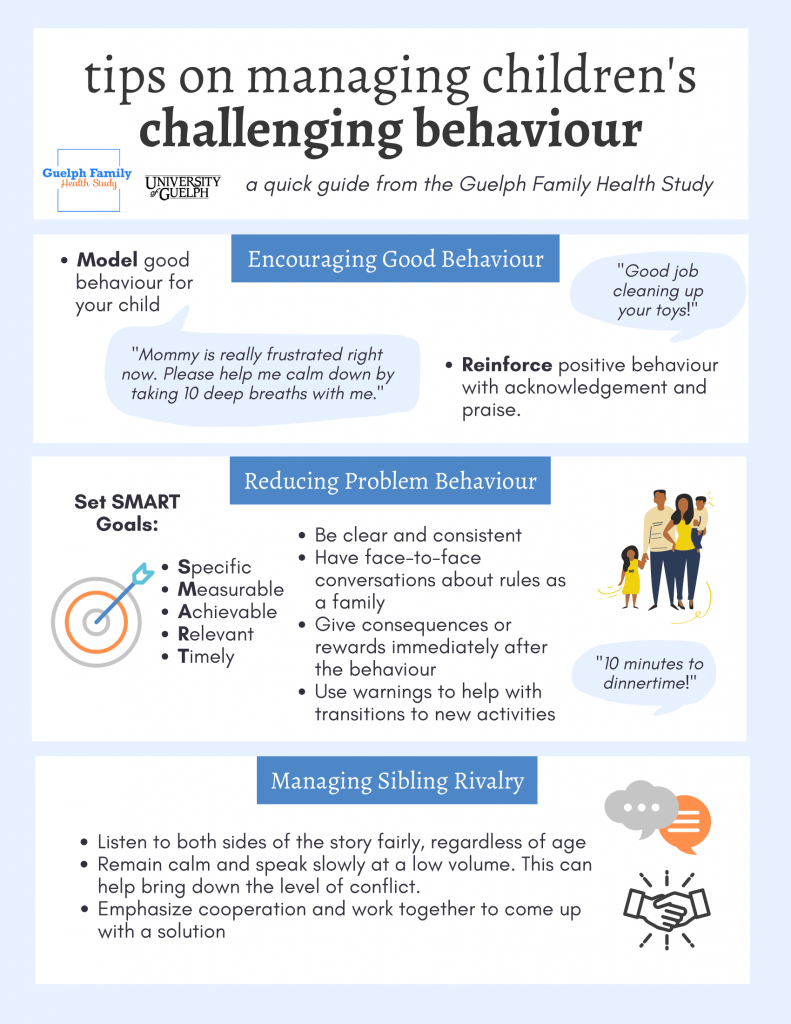Tips on managing children’s challenging behaviour
In the current context of the COVID-19 pandemic, we at the Guelph Family Health Study understand that it can be a challenging time for many families. Whether it is from disruptive or unprecedented lifestyle changes, increased stress, or simply spending so much time staying home, we have heard from many families that it is a little more difficult to manage their children’s behaviour. Below are some resources that may be helpful.

Encouraging Good Behaviour
Modelling Good Behaviour
Children notice more things than we realize. They learn by watching those around them. Practice what you preach when it comes to good behaviour.
- Point out good behaviours between adults, e.g. sharing, communicating, using good manners, taking turns
- Model how to calm down, e.g. taking deep breaths together, drinking a glass of water together (both when the child is frustrated or when you are)
- Express your actual feelings instead of using critical statements that might attack the other person, e.g. “I am feeling sad/frustrated/angry” rather than “You are driving me crazy”
Reinforcing Your Child’s Good Behaviour
- Catch your child doing the right thing! Instead of only giving attention to bad behaviour (“If I misbehave, I’ll get attention”), make sure to do the same to and acknowledge your child’s good behaviour
- Give praise or acknowledge even small things, like saying please/thank you, actively listening, speaking at a lower volume (inside voices), sharing
- “Good job doing _____!” or “Thank you for _____”
Managing Problem Behaviour
Tips to Prevent Problem Behaviours
- As a family, be clear about the behaviours you want to encourage or discourage. Your children may not understand on the first try — repeat as necessary to make your expectations clear.
- Have a focused and face-to-face conversation about goals or expectations, rather than a distracted one.
- Use warnings to help with transitions to new activities, e.g. 10 minutes to dinnertime, screen time is ending in 3 minutes.
- Ask questions or give instructions one at a time rather than all at once.
Set SMART goals:
- Specific: What is the expected behaviour? (e.g. “in bed by 9PM” vs. “sleeping early”)
- Measurable/Observable: How can we agree the behaviour happened? What counts?
- Achievable: Is this goal behaviour appropriate for the child’s current age/cognitive maturity? Will it work with our schedule?
- Relevant: Is this goal behaviour something we want to achieve? As a parent, there are only so many rules you can enforce – which ones are the most important to you/your family?
- Timely: When will we administer rewards/consequences for this behaviour?
Consequences
- Identify what the consequence will be for unwanted behaviour, e.g., time out, and positive behaviour, e.g., praise.
- Be consistent. Consequences work when children know what to expect every time.
- Give immediate consequences. The consequence needs to implemented very soon after the behaviour for children for children to link the consequence with the behaviour.
- Remember to reinforce good behaviour, not just look for unwanted behaviour.
- Avoid positive ‘punishment’, i.e. cleaning up for your child when they dawdle.
Sibling Conflict and Rivalry
Although it can drive us crazy as parents, sibling rivalry is normal and common.
How do I know when to intervene?
The ‘Traffic Light’ Guideline can help you identify when and how to intervene:
- Green light
- Normal bickering, minor teasing
- Stay out of it, but be aware of escalation
- Yellow light
- Increased volume, harsher teasing or name calling, threats, possible physical contact
- Acknowledge the conflict and each child’s anger and point of view
- Orange light
- Potential to be a dangerous situation, more serious, half play/half real fighting
- Be firm, stop the situation, review rules that both should follow, guide conflict resolution as a mediator
- Red light
- Situation has escalated to a dangerous level, significant harm may occur
- Stop and separate the children, speak with them separately first and then together, review rules, impose a plan of conflict resolution that involves both parties
When managing conflict, try to use it as an opportunity for your children to:
- Practice communication and conflict resolution skills
- Practice patience and honesty
- Negotiate and compromise
- Learn to stand up for themselves
Effective strategies for managing conflict:
- Be sure to listen to both sides of the story fairly, regardless of age
- Be receptive to what your children may need, based on age, level of conflict, nature of conflict
- Remain calm and speak slowly at a low-normal volume. This can help bring down the level of conflict and is a good chance to model patience.
- Emphasize cooperation, e.g. working together to come up with a solution, giving each other permission to speak/get up
Additional Resources
- How to Make Time Outs Work: https://childmind.org/article/how-to-make-time-outs-work/
- Managing Children’s Challenging Behaviours in the Midst of COVID-19: https://behaviortherapyassociates.com/blog/social-emotional-learning/managing-childrens-behavior-during-coronavirus/
- Using Rules for Discipline that Works: https://centerforparentingeducation.org/library-of-articles/discipline-topics/using-rules-discipline-works/
- How to End Sibling Rivalry in 6 Simple Steps: https://www.positiveparentingsolutions.com/sibling-rivalry
- Sibling Rivalry: https://kidshealth.org/en/parents/sibling-rivalry.html
Sources
- Coping with Sibling Rivalry: https://centerforparentingeducation.org/library-of-articles/sibling-rivalry/coping-sibling-rivalry/
- How to Shape & Manage Your Young Child’s Behaviour: https://www.healthychildren.org/English/family-life/family-dynamics/communication-discipline/Pages/How-to-Shape-Manage-Young-Child-Behavior.aspx
- Managing Problem Behaviour at Home: https://childmind.org/article/managing-problem-behavior-at-home/

